¿Desea crear una página independiente para las entradas de blog en WordPress?
Por defecto, WordPress muestra las entradas de su blog en la página de inicio. Sin embargo, si usted está haciendo un sitio web de negocios o simplemente desea personalizar su página de inicio, entonces es posible que desee una página separada para su sección de blog.
En este artículo, le mostraremos dos formas de crear una página separada para entradas de blog en WordPress.
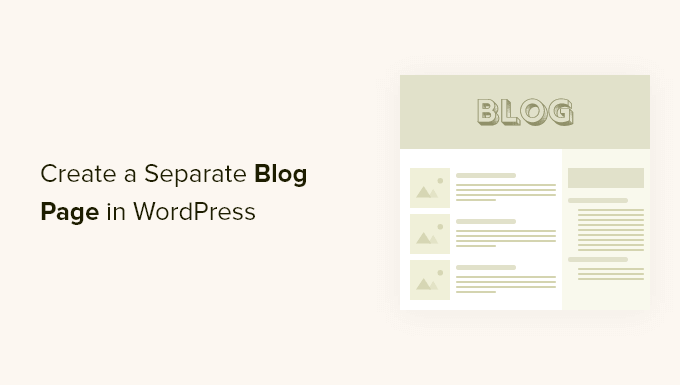
¿Por qué mostrar las entradas del blog en una página aparte?
La página de inicio es la página principal de su sitio web WordPress y la primera página que ven sus visitantes. Por defecto, WordPress muestra tus entradas más recientes en tu página de inicio, y eso tiene sentido si tienes un blog.
Pero no siempre es ideal para sitios web de pequeñas empresas. Probablemente querrá una página de inicio más atractiva que informe a los usuarios acerca de su negocio, productos y servicios, les permita saber cómo ponerse en contacto con usted y aumente la conversión de sus ofertas.
Ahora bien, si también quiere tener un blog en su sitio web, entonces tendrá que proporcionar otra página donde los visitantes puedan ir a leer sus entradas.
Dicho esto, le mostraremos cómo crear fácilmente una página separada para entradas de blog en WordPress.
En este tutorial, hemos discutido dos métodos, y puede utilizar los enlaces de abajo para saltar al método de su elección. Tenga en cuenta que el segundo método es el más sencillo y ofrece la mayor personalización:
Tutorial en vídeo
Si prefiere instrucciones escritas, siga leyendo.
Método 1: Crear páginas separadas para entradas de blog en WordPress
Puede crear una página separada para las entradas del blog utilizando los ajustes por defecto de WordPress.
Sin embargo, este método requiere un poco más de trabajo que el método 2 y no ofrece tantas opciones de personalización.
Crear una página de inicio y una página de blog separadas
En primer lugar, tendrá que crear dos páginas separadas en WordPress para utilizarlas como página de inicio / página de blog.
No tiene que añadir ningún contenido a esas páginas y puede ponerles el nombre que quiera. Por ejemplo, algunos sitios web de empresas utilizan “Noticias” para su página de blog.
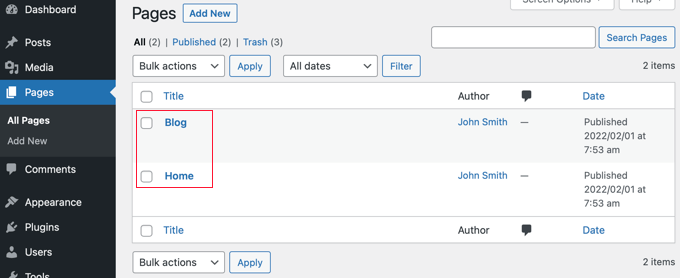
Una vez que haya creado esas páginas, visite la página Ajustes ” Lectura en el área de administrador de WordPress.
En la sección “Su página de inicio”, haga clic en el botón “Una página estática”.
A continuación, puede seleccionar las páginas de inicio y blog que creó anteriormente. A continuación, desplácese hacia abajo y haga clic en el botón “Guardar cambios”.

Ahora, cuando navegue a la pantalla Páginas ” Todas las páginas desde el escritorio de WordPress, verá que la página de inicio está etiquetada como ‘Página de inicio’ y la página de blog está etiquetada como ‘Página de entradas’.
Haz clic en el enlace “Ver” situado bajo la página del blog para obtener una vista previa.
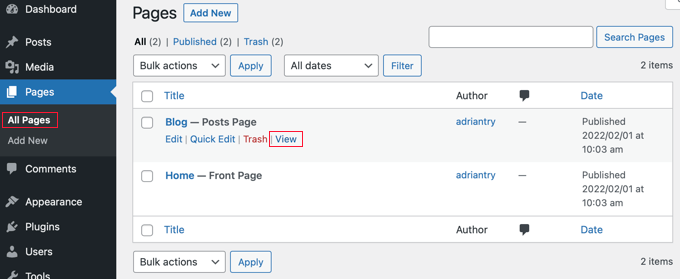
La apariencia de estas páginas depende de su tema de WordPress, y puede que desee establecer estos ajustes.
Por ejemplo, si tu tema tiene un menú de navegación, entonces notarás que WordPress ha añadido automáticamente las nuevas páginas de blog y de inicio. Si no es así, consulte nuestra guía para principiantes sobre cómo añadir un menú de navegación en WordPress.
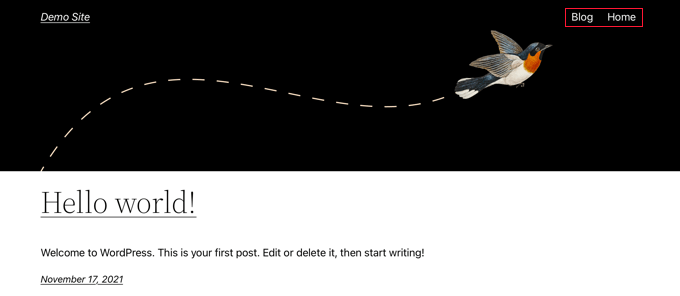
Personalizar la página de inicio / página de inicio
Hasta ahora, su nueva página de inicio está en blanco. Ahora es el momento de añadir información acerca de su empresa, productos y servicios, y de indicar a sus visitantes cómo pueden ponerse en contacto con usted.
Puedes aprender cómo hacerlo en nuestra guía sobre cómo crear una página de inicio personalizada en WordPress. En el Método 1, te mostramos cómo utilizar el editor de bloques para añadir imágenes de portada, columnas, tablas, texto y medios, galerías y mucho más.
También encontrará muchas ideas creativas de personalización en nuestra guía sobre cómo editar una página de inicio de WordPress de forma fácil y eficaz.
Personalice la página de su blog
Si está satisfecho con el aspecto de la página de su blog, el trabajo ha terminado.
Sin embargo, si está utilizando un tema basado en bloques, también puede personalizar la página de su blog visitando la pantalla Apariencia ” Editor desde el escritorio de WordPress.
Una vez allí, seleccione la opción “Páginas” en la columna izquierda del editor del sitio completo.
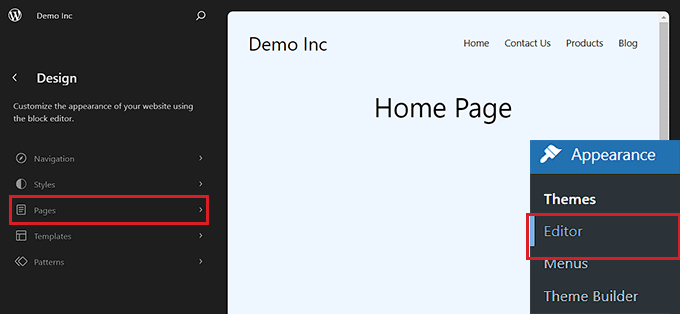
Se abrirá una lista de todas las páginas de su sitio web en la columna de la izquierda.
Desde aquí, seleccione la opción de página “Blog” y, a continuación, haga clic en la vista previa de la página de la derecha para empezar a personalizar la página de su blog.
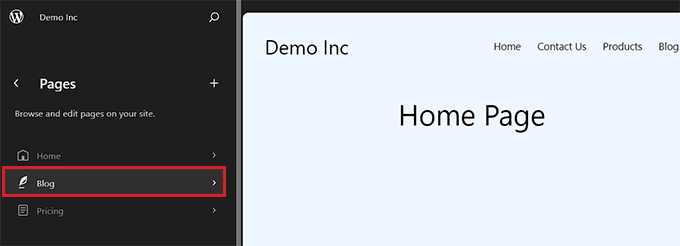
Ahora puede hacer clic en el botón “+” de la esquina superior izquierda de la pantalla y añadir los bloques que desee a la página.
Además, puede cambiar el fondo, el texto o el color de los enlaces de la página de su blog haciendo clic en el icono “Estilos” situado en la esquina superior derecha de la pantalla.
Se abrirá un panel de bloques a la derecha desde el que podrá hacer clic en la pestaña “Tipografía” para cambiar el color del texto, en la pestaña “Colores” para cambiar el color de fondo y en la pestaña “Disposición” para configurar las dimensiones de la página de su blog.
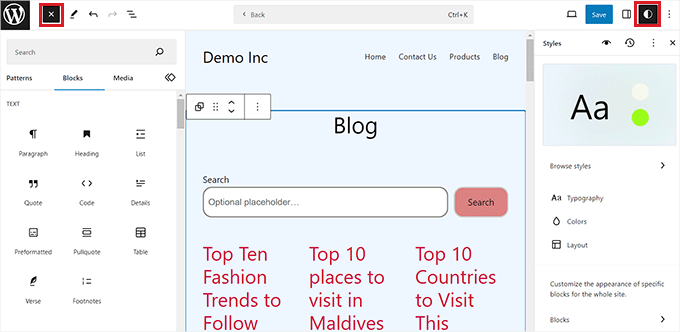
Cuando hayas terminado, no olvides hacer clic en el botón “Guardar” de la parte superior para guardar tus ajustes.
Ahora, puedes visitar la página de tu blog WordPress para ver cómo queda.
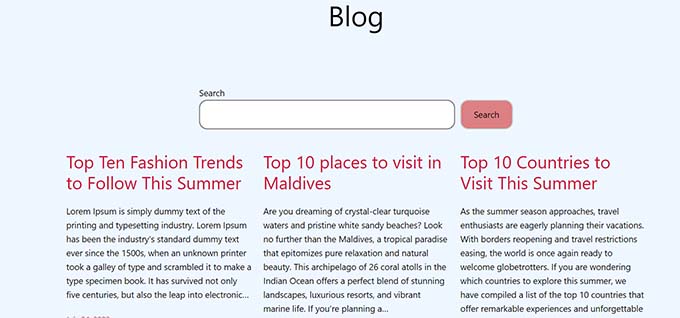
Sin embargo, si utiliza un tema clásico, deberá utilizar el método 2 para personalizar la página de entradas de su blog.
Método 2: Creación de una página personalizada para entradas de blog con un maquetador de arrastrar y soltar (Recomendado)
Un plugin maquetador de temas permite crear fácilmente un tema de WordPress personalizado sin necesidad de código. Esto incluye la posibilidad de crear y personalizar una página independiente para las entradas del blog.
Instalación del maquetador de temas SeedProd
Primero, necesitas instalar y activar el plugin SeedProd. Para más detalles, consulte nuestra guía paso a paso sobre cómo instalar un plugin de WordPress.
SeedProd es el mejor editor de arrastrar y soltar página de WordPress para empresas, bloggers y propietarios de sitios web. También cuenta con un diseñador de temas que te permite personalizar fácilmente la página de tu blog y mucho más.
Puede leer nuestra reseña / valoración completa de SeedProd para más detalles.
Tras la activación, visite la página SeedProd ” Ajustes para introducir su clave de licencia. Puede encontrar esta información en su cuenta del sitio web de SeedProd.

Después de eso, es hora de crear un tema de WordPress personalizado. Esto es mucho más sencillo de lo que parece.
Creación de un tema de WordPress personalizado
En primer lugar, debe visitar la página del maquetador de temas de SeedProd. Aquí, usted utilizará uno de los temas listos de SeedProd como punto de partida. Esto reemplazará su tema de WordPress existente con un nuevo diseño personalizado.
Puede hacerlo al hacer clic en el botón “Temas”.
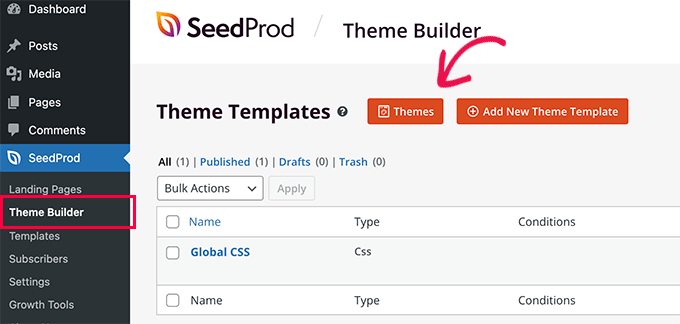
Ahora se le mostrará una lista de temas diseñados profesionalmente para diferentes tipos de sitios web.
Por ejemplo, hay plantillas denominadas “Empresa moderna”, “Agencia de marketing” y “Tema de agente hipotecario”.
Eche un vistazo a las opciones y seleccione la que mejor se adapte a sus necesidades al hacer clic en el icono de la marca de verificación.
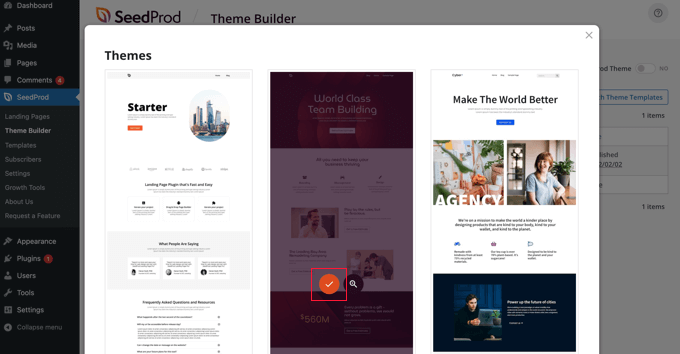
Una vez que haya elegido un tema, SeedProd generará todas las plantillas de temas, incluyendo una para el índice de su blog y otra para su página de inicio.
No se trata sólo de páginas vacías, sino que vienen establecidas con atractivas disposiciones y marcadores de posición de contenido fáciles de personalizar.
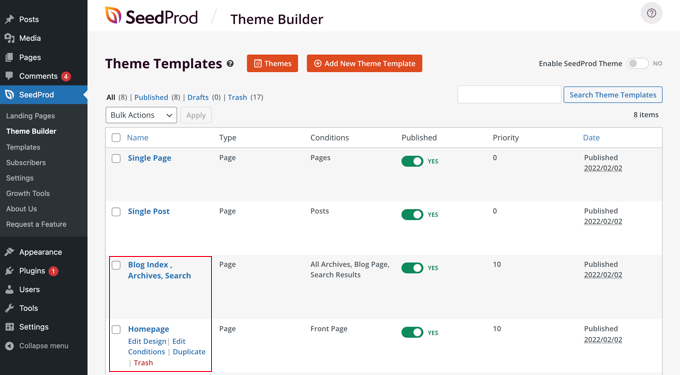
En este tutorial, le mostraremos cómo personalizar las plantillas de la página de inicio y del índice del blog.
También puedes personalizar las otras plantillas. Para saber cómo hacerlo, consulta nuestra guía para principiantes sobre cómo crear fácilmente un tema de WordPress personalizado.
Personalizar la página de inicio / página de inicio
Una vez que haya generado sus plantillas de temas, puede editarlas utilizando el maquetador de temas de SeedProd. Comenzaremos con la plantilla de página de inicio.
Para empezar, sólo tiene que enlazar el enlace “Editar diseño” situado bajo la página de inicio.

Esto iniciará el archivo de plantilla en el maquetador de temas de SeedProd.
Este sencillo maquetador de arrastrar y soltar mostrará una vista previa en vivo de su página a la derecha y una barra de herramientas de bloques a la izquierda.
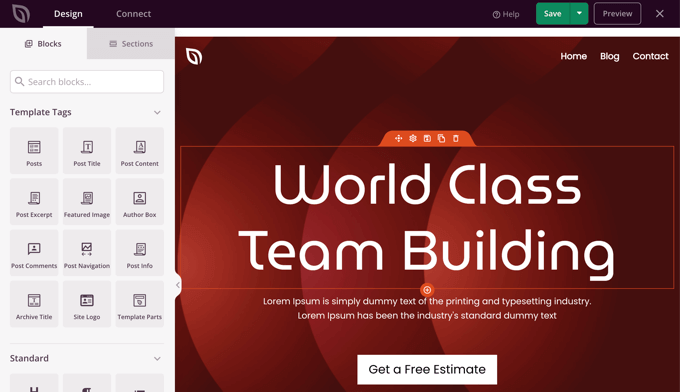
Puede personalizar cualquier bloque al hacer clic en él, arrastrar bloques arriba y abajo con el ratón y añadir nuevos bloques a la página.
Hemos escrito una guía completa sobre cómo crear una página de inicio personalizada en WordPress. Simplemente desplácese hacia abajo hasta el Método 2 para aprender a personalizar su página de inicio utilizando SeedProd.
Personalice la página de su blog
El maquetador de temas de SeedProd también ofrece muchas formas de personalizar la página de índice de tu blog.
Al hacer clic en el enlace “Editar diseño” situado debajo de la página, podrá empezar con los primeros pasos.

Verás el mismo panel de vista previa a la derecha y la barra de herramientas a la izquierda. Puede personalizar la página de blog del mismo modo que lo hizo con la página de inicio.
Por ejemplo, al hacer clic en el titular, podrás ver todos sus ajustes. Puedes editar el texto, cambiar la alineación y el tamaño de la fuente, y mucho más.
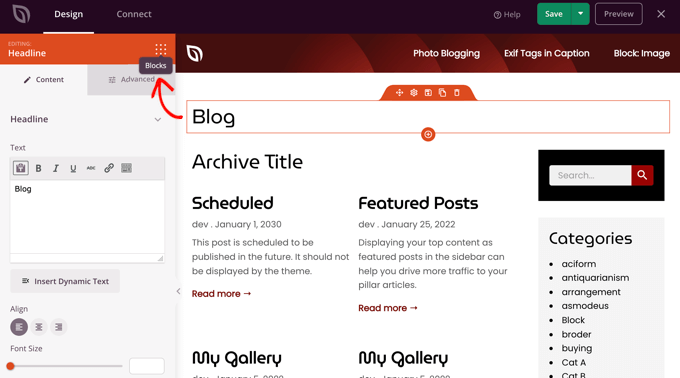
Cuando hayas terminado, tendrás que hacer clic en el icono “Bloques” para volver a la barra de herramientas.
El maquetador de temas SeedProd ofrece bloques adicionales de partes de plantillas, como el bloque Entradas, que muestra una lista de las entradas de tu blog.
El bloque Entradas ya se ha añadido a la plantilla de índice del blog para ti, y en esta plantilla, el bloque muestra tus entradas en dos columnas. Podemos cambiar esto a una sola columna.
Simplemente haz clic en el bloque Entradas y cambia el ajuste “Columnas” a 1.
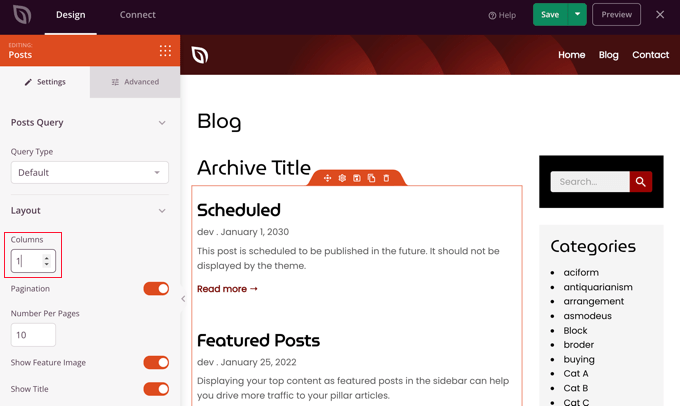
La estructura / disposición / diseño / plantilla cambiará inmediatamente a una sola columna.
A medida que te desplazas por los ajustes del bloque Entradas, encontrarás conmutadores que te permiten elegir si mostrar o no la imagen y el título de la característica de la entrada. También puedes elegir qué etiqueta de cabecera utilizar para el título de la entrada.
También hay opciones para mostrar distintos metadatos de las entradas. Puede conmutar la fecha de modificación, el autor, la fecha y hora de publicación y el recuento de comentarios.
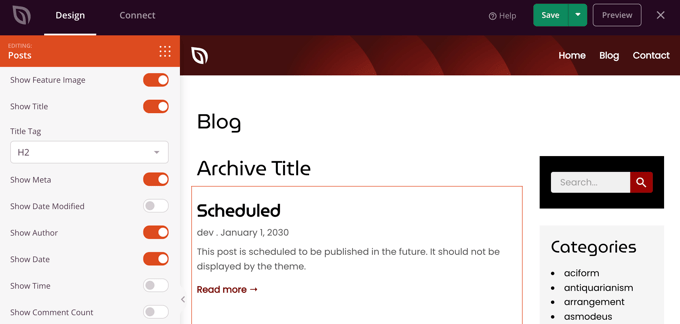
A continuación le ofrecemos otras formas de personalizar el índice de su blog:
- Puede filtrar el índice por tipo de entradas, categoría, etiqueta o autor.
- Se puede cambiar el orden / orden de las entradas.
- Puede elegir cuántas entradas se muestran en una página.
- Puede conmutar el extracto de la entrada y personalizar su longitud.
Cuando haya terminado de personalizar la página de su blog, asegúrese de hacer clic en el botón “Guardar” situado en la parte superior de la pantalla. A continuación, puedes volver a la lista de plantillas al hacer clic en el icono ‘X’.
Activar el tema SeedProd
Una vez que haya terminado de personalizar las plantillas de temas, deberá publicar el nuevo tema personalizado.
Sólo tiene que establecer el conmutador “Activar tema SeedProd” en la posición “SÍ”.
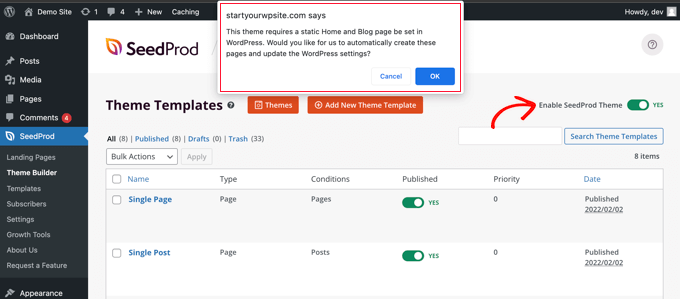
Inmediatamente verá un aviso de que es necesario cambiar los ajustes de la página de inicio / blog de WordPress. Al hacer clic en el botón “Aceptar”, se modificarán estos ajustes.
Ahora puede visitar su sitio web para ver su nueva página de inicio / página de blog. Este es el aspecto de la página de índice del blog en nuestro sitio de demostración.
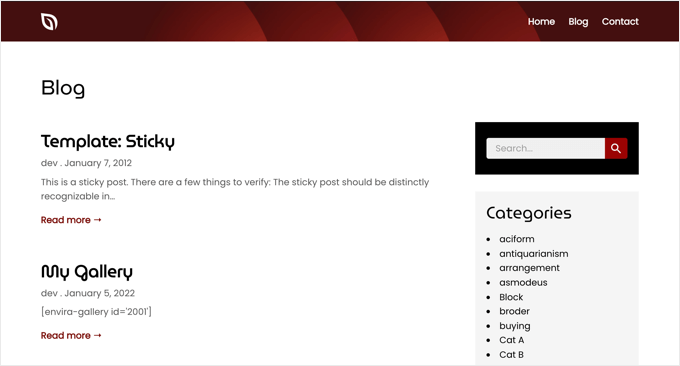
Bonus: Muestra tus entradas recientes en WordPress
Una vez que haya creado una página de blog independiente, puede seguir mostrando algunas entradas recientes en su página de inicio para animar a los usuarios a explorar más su sitio.
Para ello, abra su página de inicio en el editor de bloques de WordPress. Una vez allí, haga clic en el botón “Añadir bloque” situado en la esquina superior izquierda de la pantalla para abrir el menú de bloques.
A partir de aquí, sólo tienes que añadir el bloque “Últimas entradas” a la página. Una vez hecho esto, puedes personalizar la lista de entradas recientes para mostrar extractos de entradas, nombres de autores y fechas a tu gusto.
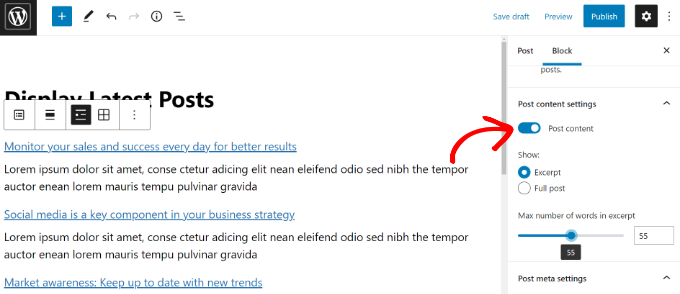
Por último, haz clic en el botón “Publicar” de la parte superior para guardar tus ajustes. Ahora, algunas de tus entradas recientes seguirán apareciendo en la página de inicio para que los usuarios pasen más tiempo en tu sitio web.
Para más información, puede consultar nuestro tutorial sobre cómo mostrar entradas recientes en WordPress.
Esperamos que este tutorial te haya ayudado a aprender cómo crear una página separada para entradas de blog en WordPress. Puede que también quieras aprender a elegir el mejor alojamiento para WordPress o marcar / comprobar nuestra lista del mejor software de chat en vivo para pequeñas empresas.
If you liked this article, then please subscribe to our YouTube Channel for WordPress video tutorials. You can also find us on Twitter and Facebook.





Syed Balkhi says
Hey WPBeginner readers,
Did you know you can win exciting prizes by commenting on WPBeginner?
Every month, our top blog commenters will win HUGE rewards, including premium WordPress plugin licenses and cash prizes.
You can get more details about the contest from here.
Start sharing your thoughts below to stand a chance to win!
Samson says
I created a blog using the static homepage setting. But I have an issue. All the details of my blogs are opened in my blog section. My goal is to make it write a little tent about each blog section and skip to the next blog topic so that when clicked on, it would open fully the selected blog
Njofie Wilso says
Great video. Really helpful.
I love WPbeginner.
WPbeginner has been a great resource to me.
Chantelle says
Thank you so much! Have been struggling like forever to figure this out!!
Patrick says
I’m trying to add posts to my blog post page, I went to the reading setting on the dashboard to enable the page I want as my blog page. Then I made a post and posted it to that blog page. It showed up on the right page, however it appears underneath the top header of the page, so the header is overlapping the post. Help!
Sarah says
Thank you this was so easy! I’ve been trying to figure this out for ages now and I stumbled across your video.
Wanda says
Hello:
Thank you so much. This was very helpful. I’m wondering if there is an easy way to create a header for the Blog page as my picture gets lost when you create a static home page. From what I gather, it can only be coded in HTML so I’m hoping there is more current good news on this.
WPBeginner Support says
Hi Wanda,
You can try this, edit the blog page and set the image you want to use in the header as featured image. Most themes use the featured image as header in their page templates.
Administrador
Tina Venema says
what can i do so my home page feature image does not override the feature image I have chosen for my blog post page called ‘stories’. I have made my homepage static. thanks.
WPBeginner Support says
Hi Tina,
It depends on your theme. Normally, if you set a featured image for your homepage then it should only appear on the homepage. However, some users confuse the featured image with the site-wide header image. Please contact your theme’s author for support, they would be able to help you out.
Alison says
My posts are showing up as a thumbnail image. I just want it to look like a regular blog. What am I doing wrong?
Paige says
This was perfect. Informative and easy to follow. Thanks so much!
Randy says
Hi…I have followed the instructions but STILL don’t see my posts on my blog…also, my text in my welcome and about pages is at the bottom of the page…any ideas how to fix both of these…thx so much for your help…
Ellen Thornthwaite says
Why doesn’t my WordPress look like this in the video? I have no ‘Reading’ under ‘Settings’. I have created a page called News and I have written a separate blog post but I cannot understand how to link the two.
Binay says
Exactly! I am facing a similar problem.
Wood Hughes says
Is it possible to have multiple posts pages in WordPress?
My concept is one page for gardening posts, one for real estate advice, and one for commerical land training information.
WPBeginner Support says
Hello,
Please see our guide on how to add topics in WordPress navigation.
Administrador
Mathukutty P. V. says
Just found this tweet and tried. Never knew about creating a page for blog posts. Thanks a lot.
Mary says
The information of easy to follow and helped me do what I’ve been trying to accomplish for awhile. Thx
Max Shea says
Complicate the simple. Make the simple complicated. That’s WordPress.
tricia norris says
Your explanation makes sense, but where does the existing home page go? I am creating a new home page, but does that mean I need to build a new home page?
Micki Allen says
Thank YOU!
Anirban Karmakar says
Is there any SEO benefits to Create a Separate Page for Blog Posts in WordPress? Or any SEO losses when I change my default Blog Post location to a custom page?
Sally says
Hello! This is great…but! Can you help me add a SECOND blog page to my website?
WPBeginner Support says
Hi Sally,
If you want to add numbers below blog page, then please see our guide on how to add numeric pagination in WordPress.
Administrador
Danielle says
How to add a blog page to page builder for mobile menu in wordpress? It seems like The blog page isn’t visible there.
Joan says
this article was great. I think I need to start over! cause when I click on blog, the blog I wrote is over all the pictures from the front page and from the one I attached to a particular blog. This is way too hard.
Olivia says
Hey, could you please help me? I really want to be able to sort my posts into different pages on my blog to keep things organized. Is this possible? If not, is there any alternative that could help me to post images with captions sort of like “posts” instead of just making the page look like that permanently? I want to be able to view a sort of gallery of images, and when I click on them get the full-screen version with captions. I found a perfect theme to let me do this, but I can’t get these to go anywhere but the front page! I really want to copy these posts onto my different pages.
Kim says
THANK YOU. This was driving me nuts and your explanation couldn’t have been easier for this non techie website builder
Mort Wakeland says
The info and video seem a bit dated for my WordPress does not have some of the options discussed. The video is pretty good except in places she skips steps. We are beginners, not experts, and we need all the “bread crumbs” we can get.
I followed the directions as best as I could, knowing this latest version of Word Press does not have a lot of the steps mentioned, e.g., there are no “discussions” to uncheck.
When I access my website, there was a static page with only Home listed. Where is Blog?
Reading additional sites, it appears the theme one installs has something to do with what shows and does show on the home screen – correct? To me this is a convoluted mess with no straightforward instructions. Most frustrating. If the theme is important, as some websites suggest, then why is it not one of the first things mention?
For me – I’ve already generated a blog and it works. I need to also generate a webpage for the communications class I’m in. So, with a blog already present, how does one add a static home page, wherein one can access the blog that has already been made in WordPress. Seems straightforward – but it’s not for I cannot find a fix to this question. Any advice, suggestions on sites to read, would be appreciated. This is like making a “mountain out of a molehill.”
Best evening wishes,
Dave says
I followed written directions using WordPress 4.9.1 and found the discussions checkbox; try ignoring the video.
To have the Blog page be selectable as the Posts page, you have to create the Blog page first.
Themes may mangle a lot of WordPress instructions, there’s no way an instructional blog can know that, and it might be discouraging to state that at the beginning; this kind of thing is generally normal in many things you can customize.
You can add a static home page in Setttings > Reading as stated in the instructions.
Ern Miller says
I created a page called “Blog” and linked to it, but I cannot figure out how to add blog posts to it, except to edit the “Blog” page as a static document. I cannot figure out how to link to blog entries.
IShita says
My admin side bar doesn’t show me the reading tab everyone is referring to. I am using WordPress.com and want to post different blog posts to different pages. Just blog posts. Nothing else. Help Please. I have zero background in CSS or anything as such.
Thanks.
WPBeginner Support says
Hi IShita,
This article is about self hosted WordPress.org websites. Please see our guide on the difference between self hosted WordPress.org vs free WordPress.com blog.
Administrador
Sam Jane Price says
Thanks so much for this info. Quick & easy fix
Danielle says
I set up my site similar to the video except that I have my posts as News, and they are pushed to the News page. However, once a user navigates away from the homepage to the News page, the menu breaks and they cannot get back home, unless by clicking the back button. I know this has something to do with my file hierarchy (as I installed wordpress to my server manually) but I can’t identify where to fix this. Anyone have an idea what I’m doing wrong? Much appreciated!
Vidya Venugopal says
Problem solved, Thanks!
Anjali Kulkarni says
Still it not clear to me I have my own site at and it has some pages too but I want more pages for different section just like this site has “start here” deal and so on if create pages then how to add that blog to specific page, please explain in details….
gabriel says
This solved my problems, thanks
Soren Pejstrup says
Thanks for all you great content. I’m shifting fra Joomla to WordPress, and I’m enjoying it – and you’re helping me on the way. Thanks so much.
I’ve build out a couple og blog pages on different sites new.
In Joomla I was used to sort pages with post by popularity so that the most visited (not the newest) where on top.
Do you know how this can be done in WordPress?
Thx Soren
Sara says
This was just what I was looking for. I usually use WordPress templates that already have the blog page specified, but now I won’t need to do that. Thanks to your instructions, I can easily do it myself!
Laura says
I have all of this set up, but now my header image will not show up on my posts page. It shows up on the backend (I use visual composer). But when I preview my blog page, it takes me to the homepage and when I actually go to my live blog page, the posts are there but not the header image.
Does it have something to do with my theme?
Thank you!
Odinn Burkni says
I have the exact same problem. There’s no header image on the blog page even though I have it set up on the page in wp-admin.
Jenn says
Thank you! This video was great, exactly what I was looking for!
Musa Hussen says
I have static page for home page and blog page for all of default post..Now I want to display some post on my home page. How could I do it. Thanks
WPBeginner Support says
Hi Musa,
There are multiple ways to do that. You can use the Display Posts Shortcode plugin. You can also use the Recent Posts Extended Widget plugin.
Administrador
peter says
hi WP beginners, how can i post multiple posts in a page. i have like sports, tech… but i can only post in the home page. please reply, thanks.
Sian says
I don’t most of those settings as my WordPress looks nothing like that. Why is that, what can I do?
WPBeginner Support says
Hi Sian,
You are probably using WordPress.com. Please see our guide on the difference between self hosted WordPress.org vs free WordPress.com blog.
Administrador
leanne ferguson says
I have created separate pages for different subject areas and now want to add multiple posts to each subject area that will have different themes I.e. one of my pages is called museum trips and exhibition’s and on that page I want to add separate blogs or posts about different museums I have visited which will include photographs. how do I do this please?
Rich says
Did you ever get an answer?? i am trying to do the same thing…google picks up your comment and brings me to this post.
Steven Denger says
Hello Leanne – I have just recently started to use “posts” instead of pages, except for 1 or 2 exceptions. You go into the Posts > Categories and create a parent category: Museum Trips. Then you can create another category and title it “Museums Visitied” (or somenthing of that nature) and make it a parent (by not checking any parent categories).Then when you make a post about Museum trips, check that category box “Museum Trips” in your post editor on the right near the page attributes. As well, when you make “Museums Visited” posts, you can check that box to indicate which category it goes under, which would be Museums Visited. Now go to your “Menus” and create menu items under the “category” panel just under the normal place of menus. You just check the boxes and then click”Add Menu Items” and then they will be linked just as any other menu link on your nav bar. When the menu links are clicked, you will see just the posts features under that particular category. It is a great way to “segment” your contents and organize them.
As you create posts about one subject or the other, just make sure you check which category it goes in and it will show up there in it’s separate feature page, just like you want.
You may have already figured this out, but I just now saw your post so I thought I would answer. Good Luck.
kelsey says
HELP!!!!!!!! THIS BROKE MY HOME PAGE!!!!!!!! I’ve now lost my actual home page where is it??? How do I undo this????????
WPBeginner Support says
Hey Kesley,
Start the tutorial again and undo the steps you took earlier.
Administrador
akhlaq says
hello, nice tips.
i would to ask you how to make my url is like this
mydomain.com/tutorial-web/post.html and not mydomain.com/category/tutorial-web/post.html
and if my visitor go to mydomain.com/tutorial-web/ the will find all post with ‘Tutorial Web’ category at that page
sorry for my bad english
Thanks for your tutorial, your website is amazing for beginner like me
Lauren says
Hi
This is a very useful post – except when I go on settings there literally isn’t a reading settings section. Can you help me?? I might just be being stupid but I need assistance asap
Thank you
Tirso says
Hi, thanks for your information, but I have a problem with the menu on my posts page in my wordpress.
Here is the thing… I created a new page for posts as you said and I set a menu I created for posts and pages (as secondary menu) and everything is fine with the menu until I switch that page to “Posts page” on “Settings > Reading”… When I do that, it changes the menu to my “primary menu” automatically and I don’t know what to do so that it takes the secondary menu…
Hope you can help me!
Donald says
I’d actually already done what you said in this video, but isn’t working as I was expecting. It does put the blog to ./blog as expected, however you can still see the blog (and about and contact etc…) on the home page if you scroll down, and I was expecting to ONLY have the Home page visible. i.e. scroll down and only see the bottom of the home page. This is with the Twelve Seventeen theme (not sure if it’s related to that?). Is there a way to make ONLY the Home page display? (from the wording of the settings you’d think that’s what you’re doing, but that’s not what I see when done – see all the same stuff as before, but now the blog has a place of it’s own in addition)
Brittinni says
How would you differentiate a home page verses an about page? I’ve read that both have a good bit of overlap.
Krishna Roy says
hello WP beginners,
First of all I want to thanks for all wp tutorials. By watching your tutorials i have created a website + Blog . Its working fine. But i want to ask one thing. I have installed “bbpress” plugin for create forum in my website and when new users want to register in my blog then ” bbpress” not sending their passwords to their emails.
Can yo help me for that? how can i configure bbpress properly for new users registration.
WPBeginner Support says
Hi Krishna,
Please see our guide on how to fix WordPress not sending email issue.
Administrador
Joyce says
OMG. Thank you so much. With all the you tube tutorials, there is nothing that I could find that actually detailed this specific required info. I am so glad I found this site. :o)
WPBeginner Support says
Hey Joyce,
We are glad that you found this article helpful. You may also want to subscribe to our YouTube Channel for WordPress video tutorials.
Administrador
Amanda says
Hi,
Thank you, but what about if there is no Template option to choose in Page Attributes? I’m working with Twenty Seventeen and it is not an option.
Mark says
Hi,
I have a static front page and a post page.
How do you put a title onto the Blog page?
It’s just it doesn’t flow with the look of the other pages! my site is so you can see what I mean.
Thanks
Mark
Jordan Stocker says
This was a life saver – thank you!!
Nancy says
Thank you for your help! I was very frustrated until you helped me.
Elakkiya says
This page is very helpful to me!!!. Thank you…